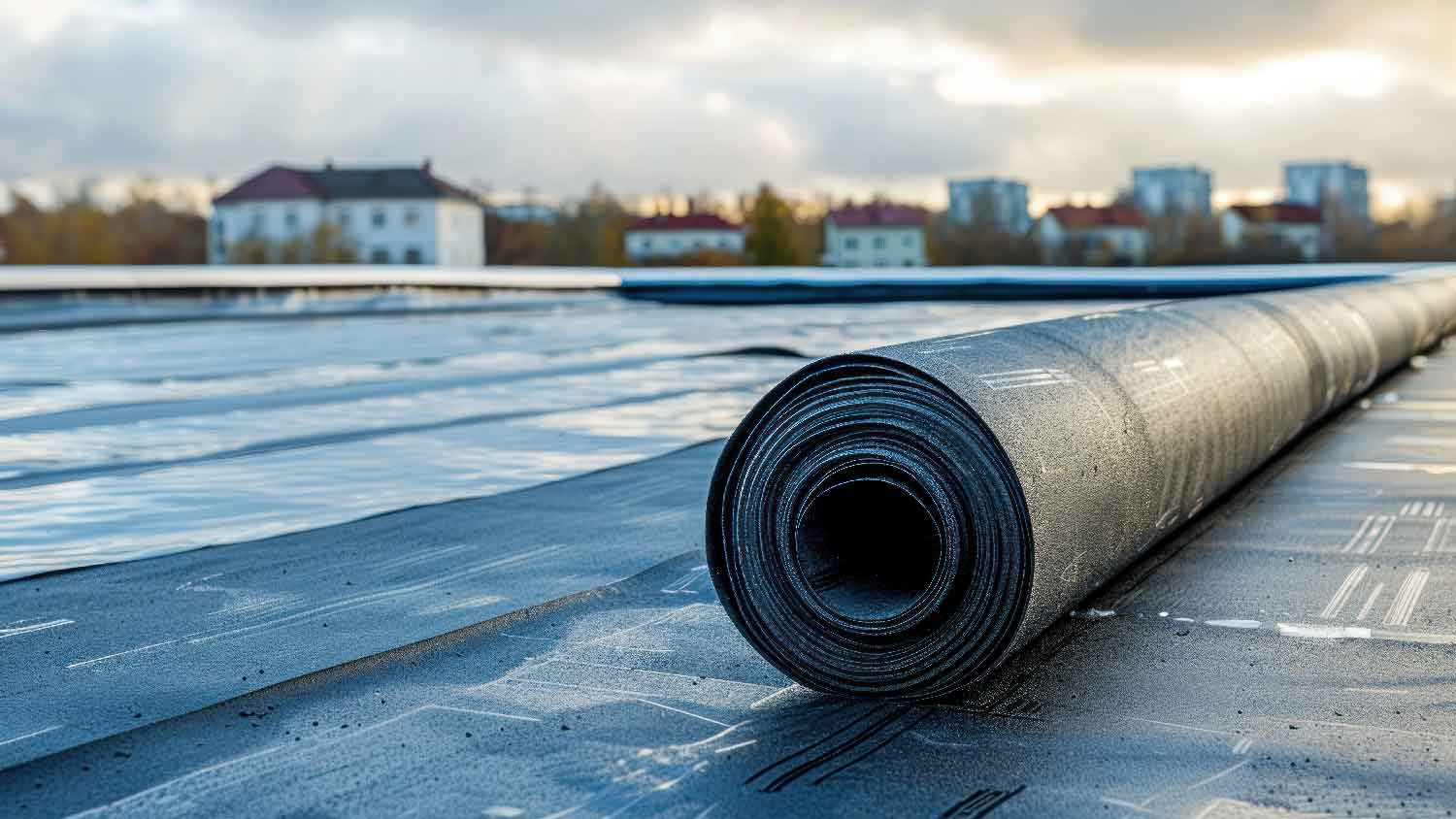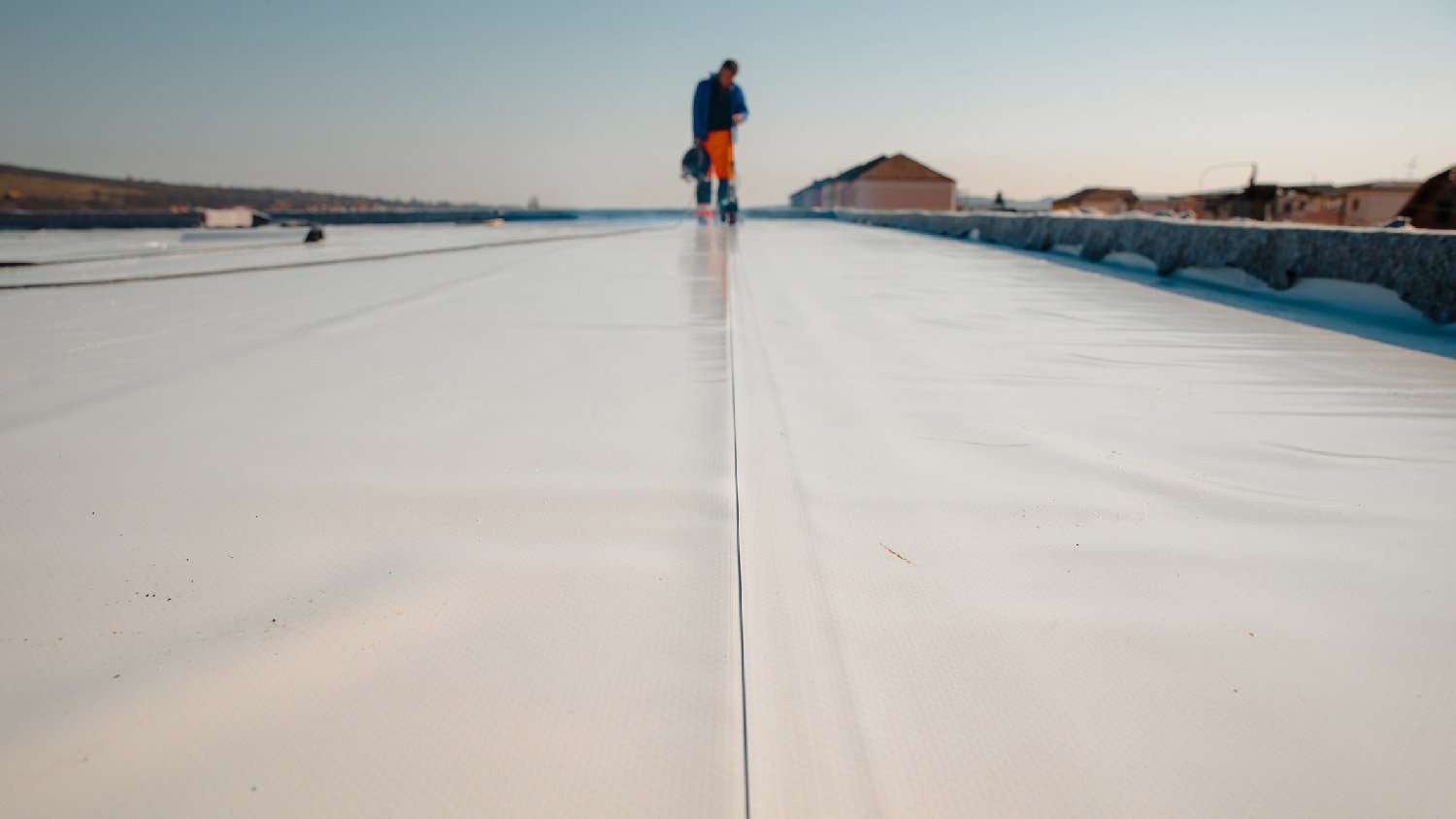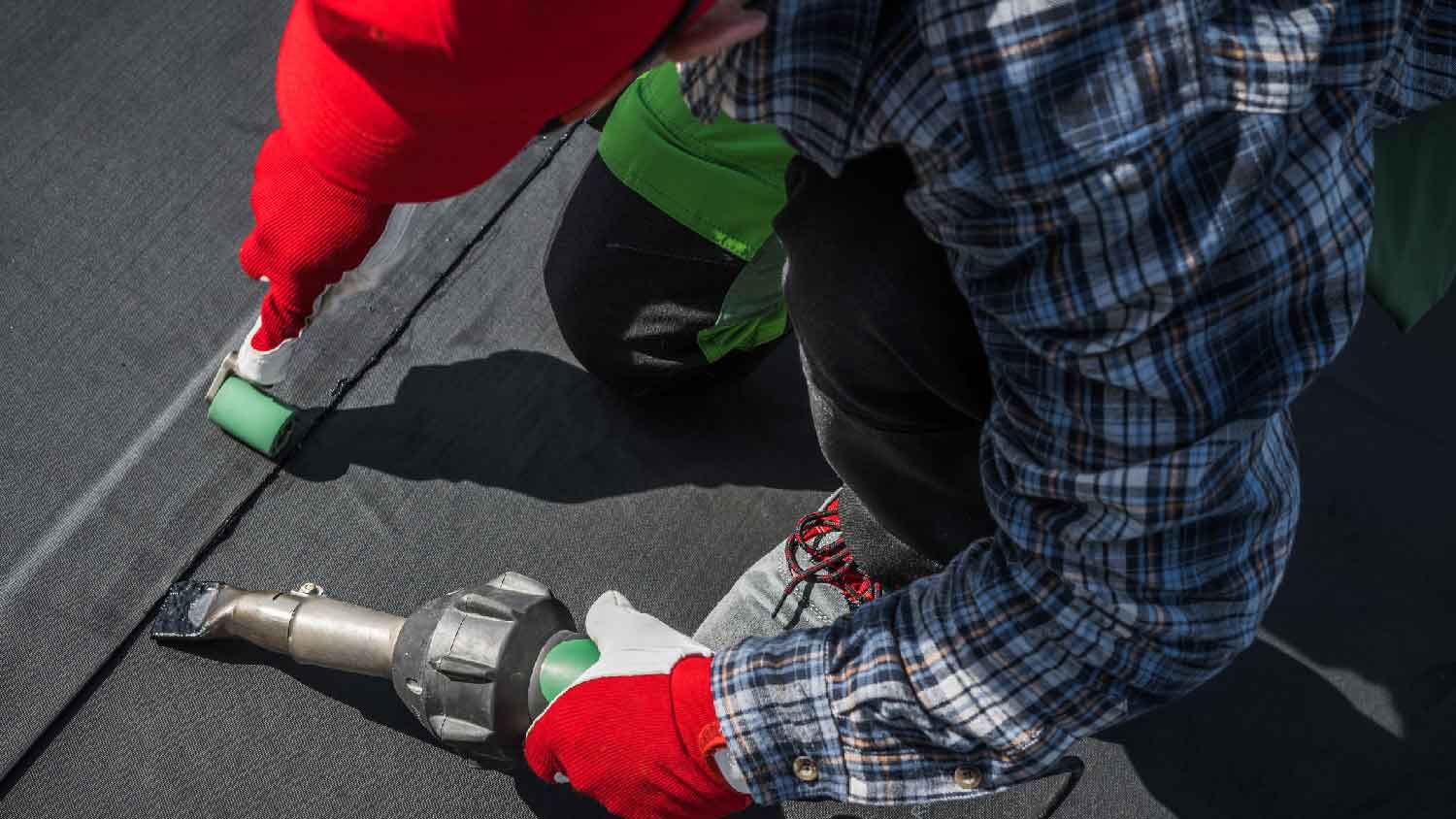
Need a new roof in the city that never sleeps? Learn about metal roof costs in New York to see if this durable roofing material is within your budget.
A protective roof over your head


EPDM and PVC are two types of single-ply roofing membranes.
Both materials are ideal options for flat or low-slope roofs.
EPDM is made from recycled materials and is fully recyclable post-use.
PVC features a variety of light color options that reflect sunlight.
Choosing the right roofing material impacts your home's durability, energy efficiency, and long-term maintenance costs. Two popular single-ply membrane options for flat or low-slope roofs are EPDM (Ethylene Propylene Diene Monomer) and PVC (Polyvinyl Chloride) roofing. To determine whether EPDM or PVC roofing is best for your roofing project, explore the key features.
Ethylene Propylene Diene Monomer (EPDM) and Polyvinyl Chloride (PVC) are two popular single-ply roofing membranes. EPDM is a synthetic rubber roofing material known for its exceptional durability and weather resistance. PVC roofing is a thermoplastic membrane with strong resistance to fire and punctures.

EPDM roofing is widely used in flat or low-slope roofing applications and is made from a blend of high-performance synthetic rubbers, giving it excellent flexibility and durability. EPDM is installed in large sheets to reduce the number of seams on a roof, minimizing potential leaks. EPDM is available in black or white and is known to withstand a range of weather conditions, including UV radiation and extreme temperatures.
The roofing material can last between 30 to 40 years but there are some key pros and cons of EDPM roofing to consider.
| Pros | Cons |
|---|---|
| Durable | Vulnerable to punctures |
| Weather resistant | Slippery |
| Cost-effective | Compatibility issues |
| Low-maintenance | Not as energy-efficient |
| Easy to install | Potential for seam failure |
Best for:
Flat or low-slope roofs
Budget-conscious homeowners
Climates with extreme temperature fluctuations
EPDM roofing is renowned for its durability. Its excellent weather resistance allows EPDM to withstand various environmental conditions, including extreme temperatures, UV radiation, and moisture. EPDM's flexibility is a significant advantage in colder environments, as it remains pliable and can accommodate building movement without cracking.
The material is available in large sheets and requires fewer seams, which speeds up the installation process and minimizes the potential for leaks. Once installed, EPDM is low-maintenance, requiring only occasional inspections and repairs. EPDM roofing cost ranges between $4 and $14 per square foot. EPDM is made from recycled materials and is fully reusable at the end of its life cycle.
The many factors that play into choosing a roofing material may surprise you, such as durability, cost, style, and the climate in which you live. Many homeowners choose asphalt, but there are various types on the market. A roofer can advise you on the best materials for your home and region.
EPDM is most often black, which is prone to heat absorption. While white EPDM options are available to help reflect sunlight and reduce heat, they are less accessible. Despite its overall durability, EPDM can be vulnerable to punctures, leading to leaks if not promptly addressed.
The installation process can pose challenges, as EPDM is installed using adhesives. If not applied correctly or if they degrade over time, the seam can fail, leading to water infiltration. EPDM may not be compatible with all roof coatings or sealants, limiting repair options and complicating maintenance. The surface of EPDM can become slippery when wet, creating a hazard for anyone needing to perform maintenance or inspections, particularly on sloped roofs.

PVC roofing is a type of single-ply roofing membrane used primarily for low-slope or flat roofing materials. Made from a durable thermoplastic material, PVC is known for its strong resistance to chemicals, fire, punctures, and harsh weather conditions. Available in white or light colors, PVC is highly reflective. PVC roofing systems are heat-welded at the seams, creating a watertight bond that enhances durability and leak prevention.
| Pros | Cons |
|---|---|
| Durability | Higher cost |
| Fire resistant | Complex installation |
| Energy-efficient | Environmental impact |
| Low maintenance | Vulnerable to punctures |
| Watertight seams | Potential for shrinkage |
Best for:
Warm climates to improve energy-efficiency
Areas with fire safety concerns
Complex roof designs
PVC's is durable, with a lifespan of 20 to 30 years. It’s also fire-resistant, which reduces the risk of fire spreading across the roof. Energy efficiency is another key benefit of PVC roofing due to its availability in white or light colors. These shades reflect sunlight to reduce cooling costs and improve the home's energy efficiency.
The seams of PVC roofing are heat-welded to create a watertight seal that greatly minimizes the risk of leaks, contributing to its long-term reliability. Once installed, PVC roofing requires minimal maintenance, making it a cost-effective option over its life span. Its flexibility also allows it to conform to various roof shapes.
PVC costs more upfront, at $4 and $15 per square foot and its installation requires precision, as improper work can cause seam failures or water infiltration. The production of PVC involves the use of chlorine and other chemicals, which raises concerns about its ecological impact.
While PVC is durable, the material is prone to punctures. Over time, PVC membranes can experience shrinkage, which can stress seams and flashings, leading to potential failures. The plasticizers that make PVC flexible can gradually migrate out of the material, causing it to become brittle and more prone to cracking as it ages.

PVC roofing is considered to have a better appearance because it's available in a variety of colors, most commonly in white or light shades. These colors provide a clean and modern look while EPDM roofing is mostly available in black and may have a less desirable appearance.
PVC is available in a wider range of colors, including white, tan, gray, and even custom colors, allowing for greater flexibility in matching the roof to the home's design or improving energy efficiency through reflective surfaces. PVC can be produced in various thicknesses and with different surface textures, offering further customization to meet specific performance or aesthetic needs. EPDM is available in black or white, with fewer options for surface variations.
While both materials feature high durability, EPDM has a longer life span than PVC. EPDM can last 30 to 40 years while PVC's lifespan ranges between 20 to 30 years.
EPDM and PVC feature similar cost ranges, but PVC can be slightly more expensive. EPDM costs $4 to $14 per square foot while PVC costs $4 to $15 per square foot.
EPDM roofing has a simpler installation process as the material comes in large sheets rolled out over the roof, with fewer seams, reducing the complexity and time required for installation. PVC roofing requires more precise installation, especially at the seams, which are heat-welded to create a watertight bond. Installing PVC requires hiring a local roofing contractor to ensure precision.
EPDM is known for its resilience and ability to withstand various environmental factors, requiring minimal upkeep. Its flexible nature allows it to endure building movement and temperature fluctuations without cracking, reducing the need for frequent repairs. PVC roofing, while also durable, requires more careful monitoring due to the potential for issues like seam failures from improper installation or plasticizer migration, which can lead to brittleness.
EPDM is made from a synthetic rubber material produced with a significant portion of recycled content. The material is fully recyclable at the end of its life, reducing landfill waste. The manufacturing process for EPDM is less harmful to the environment, as it does not involve using chlorine or other hazardous chemicals as PVC does.
From average costs to expert advice, get all the answers you need to get your job done.

Need a new roof in the city that never sleeps? Learn about metal roof costs in New York to see if this durable roofing material is within your budget.

Learn about average roof repair costs in New York City and what factors can affect your total to set your budget appropriately.

A new roof boosts curb appeal and home value and keeps your property protected. Learn about roof replacement costs in New York City to budget accurately.

A leaky roof is less than ideal. Learn how to patch a roof while you wait for repairs from the pros to prevent further damage to your home.

There is a calculation for how many soffit vents you need, depending on your square footage. Discover where to install them and what happens to your attic air during winter.

If you need a new flat roof, learn about tar and gravel roof costs and what can affect your total to make sure you budget accurately.